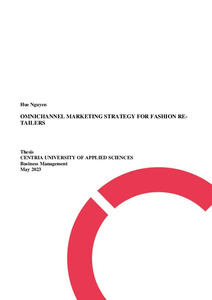Omnichannel marketing strategy for fashion retailers
Nguyen, Hue (2023)
Nguyen, Hue
2023
All rights reserved. This publication is copyrighted. You may download, display and print it for Your own personal use. Commercial use is prohibited.
Julkaisun pysyvä osoite on
https://urn.fi/URN:NBN:fi:amk-2023051410622
https://urn.fi/URN:NBN:fi:amk-2023051410622
Tiivistelmä
Impacts of COVID 19 and severe inflation have changed the fashion retailing landscape. A significant number of the retailers went bankrupted while many are still striving to survive in the retailing market. Particularly, the rise of digitalization, along with the pandemic crisis and the inflation surge, has changed the way fashion consumers observe, shop and engage with brands. Understanding the major impacts on the fashion retailing industry is crucial for practitioners to recover and thrive, and omnichannel market-ing became a survival strategy.
The exploratory study intended to investigate major influential forces in the fashion retailing industry, clarify the importance of omnichannel marketing strategy and introduce omnichannel marketing strate-gies. This thesis summarizes previous empirical and theoretical literature to provide relevant proven evi-dence and a more comprehensive understanding.
A survey was conducted on 83 participants via snowball sampling to investigate consumer and prefer-ences of fashion shopping. A general framework of omnichannel marketing strategies was made based on the results.
The study revealed that the border between online and offline shopping channels are getting blurry. Fashion customers tend to be online while shopping in stores and prefer to experience offline services while shopping remotely. The increase of social media or digital channels provide practitioners more opportunities to meet and engage with potential customers. Additionally, touchpoints between retailers and customers vary from online to offline channels and vice versa through stages of purchasing. Addi-tionally, the customer profiles of fashion shoppers share several common characteristics across border.
However, the study had some limitations. The thesis was conducted on representative groups of the population via the snowball sampling method that might affect the internal and external validity. The study only focused on the fashion retailing industry in general, so the outcomes may not be appropriate-ly applicable for all business types.
The exploratory study intended to investigate major influential forces in the fashion retailing industry, clarify the importance of omnichannel marketing strategy and introduce omnichannel marketing strate-gies. This thesis summarizes previous empirical and theoretical literature to provide relevant proven evi-dence and a more comprehensive understanding.
A survey was conducted on 83 participants via snowball sampling to investigate consumer and prefer-ences of fashion shopping. A general framework of omnichannel marketing strategies was made based on the results.
The study revealed that the border between online and offline shopping channels are getting blurry. Fashion customers tend to be online while shopping in stores and prefer to experience offline services while shopping remotely. The increase of social media or digital channels provide practitioners more opportunities to meet and engage with potential customers. Additionally, touchpoints between retailers and customers vary from online to offline channels and vice versa through stages of purchasing. Addi-tionally, the customer profiles of fashion shoppers share several common characteristics across border.
However, the study had some limitations. The thesis was conducted on representative groups of the population via the snowball sampling method that might affect the internal and external validity. The study only focused on the fashion retailing industry in general, so the outcomes may not be appropriate-ly applicable for all business types.
